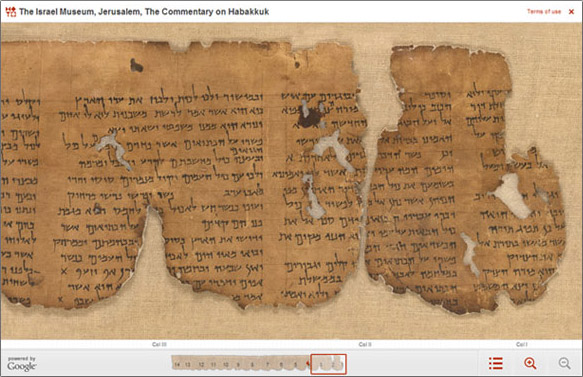The government of Israel has been getting some mixed press lately in light of the Palestinian bid for statehood in the United Nations. However, in Jerusalem the Israel Museum has been steadily making progress on a fascinating and historic project. Thanks to a collaboration between Google and this national museum, it is now possible to view in high definition some of the famous Dead Sea Scrolls. How exciting is this:
Recently I was reading a book about Timbuktu, the famous caravan stop just South of the Sahara in Mali. As an ancient center of Islamic teaching, the city contains a vast quantity of old manuscripts, dating back centuries. The authors described entering a room in someone's house to find it filled with stacks upon stacks of disintegrating old papers. One can only guess at the historical value deteriorating before their eyes, unable to be saved (it would be virtually impossible to transport such a large quantity of fragile documents out of a city as remote as Timbuktu). Hopefully the development and use of the relatively simple technology used in this project will be continued and not only save these irreplaceable resources but to provide free public access to them.
Still not convinced this project is worth checking out? Check out the official two minute video:
By the way, if you're not up to speed on the upcoming vote in the Security Council on Palestinian statehood, a decent summary can be found here.
via Image/Idea,the blog of the Lewis & Clark College Visual Resource Center
"The five Dead Sea Scrolls that have been digitized thus far include the Great Isaiah Scroll, the Community Rule Scroll, the Commentary on Habakkuk Scroll, the Temple Scroll, and the War Scroll, with search queries on Google.com sending users directly to the online scrolls. All five scrolls can be magnified so that users may examine texts in exacting detail. Details invisible to the naked eye are made visible through ultra-high resolution digital photography by photographer Ardon Bar-Hama– at 1,200 mega pixels each, these images are almost two hundred times higher in resolution than those produced by a standard camera. Each picture utilized UV-protected flash tubes with an exposure of 1/4000th of a second to minimize damage to the fragile manuscripts. In addition, the Great Isaiah Scroll may be searched by column, chapter, and verse, and is accompanied by an English translation tool and by an option for users to submit translations of verses in their own languages."It's incredible. Here you can choose a scroll to look at, and true to their description I zoomed in and moused over a random passage of the great Isaiah Scroll, and lo and behold, an English translation instantly popped up. It's like having your own private translator. Also, if the above quote didn't drive home to you the seriously quality packed into these images, remember that compared to the 1,200 mega pixels in the cameras used in this project, the average pocket-size digital camera these days has somewhere between seven and fourteen mega pixels.
- The Israel Museum
Recently I was reading a book about Timbuktu, the famous caravan stop just South of the Sahara in Mali. As an ancient center of Islamic teaching, the city contains a vast quantity of old manuscripts, dating back centuries. The authors described entering a room in someone's house to find it filled with stacks upon stacks of disintegrating old papers. One can only guess at the historical value deteriorating before their eyes, unable to be saved (it would be virtually impossible to transport such a large quantity of fragile documents out of a city as remote as Timbuktu). Hopefully the development and use of the relatively simple technology used in this project will be continued and not only save these irreplaceable resources but to provide free public access to them.
Still not convinced this project is worth checking out? Check out the official two minute video:
By the way, if you're not up to speed on the upcoming vote in the Security Council on Palestinian statehood, a decent summary can be found here.
via Image/Idea,the blog of the Lewis & Clark College Visual Resource Center
